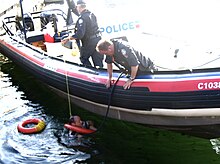Lifebuoy
Lifebuoy is the name for various buoyant life-saving appliances. Mostly as an individual rescue device for water rescue , or as a group rescue device for several people . Furthermore as a trouser buoy , as a life collar , etc.
history
The first water-saving devices of this type were inflatable animal skins or intestines next to hollowed-out pumpkins. Further developments consisted of or with cork in various forms or soldered sheet metal bodies. From 1891 on, life buoys were required by the accident prevention regulations of the maritime professional association. The first lifebuoy that resembles today's shape was registered for a patent in the United States in 1935.
Lifebuoy as an individual rescue device (current design)
The lifebuoy (also: Baywatch buoy, English Torpedo Buoy or Rescue Can) as a single means of rescue is similar to the lifebuoy or belt rescuer . It is well suited for use under difficult conditions, for example in heavy seas, long swimming distances or strong currents. The lifebuoy consists of a chest-shoulder strap that is connected to the actual buoy, a plastic float with handles, via a line. The buoyancy effect gives the rescuer additional security in the difficult conditions mentioned above. This type of buoy is also used for water rescue with dogs. Both in the commercial shipping as well as in the recreational boating and of course emergency services is to be found as rescue agents.
application

In the event of a swimmer, the lifeguard swims to the victim. He pulls the buoy behind him. Once he has reached the victim, he hands him the buoy from a safe distance if he is still conscious. Extreme caution is required to avoid being gripped by the casualty. Once the lifeguard has secured the casualty, he pulls him back to the bank .
Towing unconscious people
The lifeguard grasps the casualty in a similar way to the armpit pull . The buoy floats over the victim's chest and is held by the rescuer with both hands. In this way, the casualty can be safely transported to the bank.
Towing people with awareness
The casualty can hold on to the buoy and can either be pulled to the bank behind the rescuer or be pulled by the seaman's towing handle. The hand that is pushed under the upper arms of the casualty holds the lifebuoy. Thus, the rescuer can swim with one hand and secure the posture of the casualty with the other. In addition, this swimming style ensures constant control of the victim's vital functions .
Use as a tool and for self-defense
Thanks to its high stability, the buoy can be used as a pushing and striking tool and for self-defense in appropriate situations. It is conceivable, for example, to break the window of an accident car. If, for example, the lifeguard wants to calm down rioting people and they attack him, the lifebuoy can be used to ward off the armed attackers.
Buoy as a signaling device
On a busy beach, hand signals or calls can be quickly lost or overlooked. The buoy, which is usually delivered in bright red, is ideally suited in such environments to signal dangerous situations or the all-clear through agreed movements. It can also be used as an orientation aid for other emergency services when using water to show where the lifeguard has gone.
Self-rescue
If the lifeguard gets into a situation in which he has to spend a long time in the water, he can hold on to the buoy in order not to have to waste excessive strength.
advantages
- high self-protection of the rescuer
- easy to handle
- easy maintenance
- ready for use quickly
- several casualties can hold on to the buoy
disadvantage
- much practice required
- not faint-proof
Lifebuoy as a group rescue device
The life-buoys as a group saving means to Udet resemble the liferaft or Rettungsbake and may be equipped with automatic radio transmitters to SAR rescue organizations to alert. Small radio buoys are usually called emergency beacons .
literature
- Hartmut Goethe, Christa Laban: The individual rescue equipment. ISBN 3-7822-0442-5 (on the history of the life buoy, life ring and life jacket).
- Karl Born : Salvation Between the Fronts. Maritime emergency service of the German Air Force 1939–1945. 3. Edition. Mittler, Hamburg / Berlin / Bonn 2001, ISBN 3-8132-0756-0 .
Web links
- Regulations on buoys as a means of rescue at sea (Solas) ( Memento from January 31, 2012 in the Internet Archive ) (PDF; 31 kB)
- Description of the group rescue buoy to Udet
- German Navy rescue equipment ( Memento from July 31, 2009 in the Internet Archive ) (PDF; 3.3 MB)
Individual evidence
- ↑ Lifebuoy , U-shaped. (PDF; 3.3 MB) In: German Navy rescue equipment. Marine Press and Information Center, March 2004, p. 7 , archived from the original on July 31, 2009 ; accessed on October 2, 2016 .
- ^ Maik Brandenburg: Suitcase in distress. (No longer available online.) In: mare online. December 2001, archived from the original on June 6, 2015 ; accessed on October 2, 2016 (history of water rescue equipment). Info: The archive link was inserted automatically and has not yet been checked. Please check the original and archive link according to the instructions and then remove this notice.
- ^ Rescue at sea . In: Meyers Großes Konversations-Lexikon . 6th edition. Volume 16, Bibliographisches Institut, Leipzig / Vienna 1908, pp. 832–835 .
- ↑ Patent US2088251 : Lifesaving device. Registered September 12, 1935 , published July 27, 1937 , inventor: Henry W. Walters.
- ↑ Water rescue. Austrian Dog Water Rescue, archived from the original on December 24, 2008 ; accessed on October 2, 2016 .
- ↑ Lifebuoy . LuftArchiv.de, accessed on October 2, 2016 (private website, lifebuoy to Udet).
